
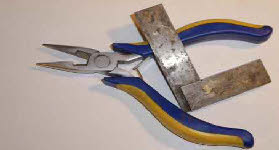

Updated March 2021
Over the years I’ve collected quite a few tools, some common, some less so, but without which I would struggle to make my models. Here’s my list of top ten, in no particular order:
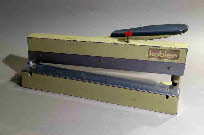 Guillotine
Guillotine
I rescued this guillotine from the waste bin many years ago, and it’s done invaluable service ever since. Cutting thin metal is not easy, using either a saw or shears. A guillotine on the other hand will happily cut brass or nickel silver up to 10 or 12th, and will cut straight, and true without distortion. It will also quite happily cut roofing lead for adding weight to stock.
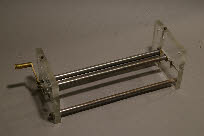 Rolling mill
Rolling mill
My rolling mill is a home made effort from steel rod, perspex, and a couple of Meccano gears. The two pinch rollers are adjustable to allow different thickness material to be rolled, and are connected by a pair of gears, so both move together. The third roller is also adjustable, and is used to control the tightness of the curve. I use this for rolling boilers, but have also successfully rolled Slater’s Plasticard brickwork to a radius of about 40mm to use under brick arches.
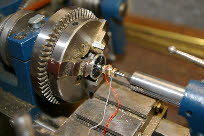 Lathe
Lathe
A lathe is not cheap, but certainly worth the investment. It gets regular use for turning small items (chimneys and domes, split axles for example) and for drilling buffer shanks for sprung buffers, amongst other things. This is a Cowells lathe which I bought about 30 years ago and is still as good as new after many year’s service, shown here being used to mount a loco wheel squarely on its axle.
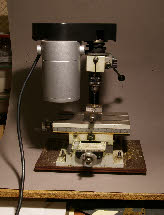 Milling machine
Milling machine
This is a Unimat 3 milling machine and milling table. It gets used a lot as a vertical drill (it saves a lot of broken drills) and less often as a milling machine. My skills as a machinist are not great, but I’ve successfully milled for example, loco coupling rods and hornguides.
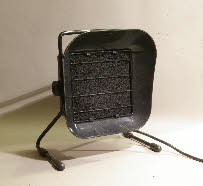 Flux fume filter
Flux fume filter
Solder flux fumes are pretty nasty, and if you’re doing a lot of soldering (a brass coach perhaps) in less-than-perfect ventilation, this is a very useful gadget, and will avoid a lot of sore throats and headaches. I bought this one from Maplins for about £20.
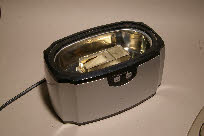 Ultrasonic cleaner
Ultrasonic cleaner
Another purchase from Maplins for about £20. Good for cleaning grease off small articles (smaller than a 4mm bogie coach for example) before painting. I’ve shown it here with a loco tender to give an idea of size. In use it would full of water - it isn’t in the photo.
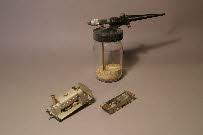 Grit blaster
Grit blaster
If you have an airbrush compressor, than a grit blaster is a good addition to the armoury. I use this regularly on brass and nickel silver followed by a dunk in the ultrasound cleaner, prior to painting. It gives an excellent key for paint. I tried it recently on a second hand white metal loco kit which needed a repaint. I was a bit concerned that it would be too aggressive, and pit the white metal, but it was fine, and took only about 10 minutes to strip the model back to bare metal. Don’t use the aluminium oxide sold with the grit blaster. It’s expensive, and leaves a horrible mucky residue on whatever you’re trying to clean. Use fine silver sand instead.
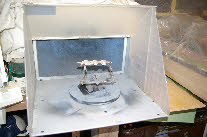 Spray booth
Spray booth
A recent purchase from Eileen’s, and well worth it. I can now happily spray in my garage, whereas before I could only spray stuff outside (ie in the summer) - shown here with a loco chassis about to take a first coat of acrylic grey primer (car spray paint). I also wear a face mask designed to absorb paint vapours (ie not a simple dust mask). If you can smell the paint vapour, the mask is not good enough.
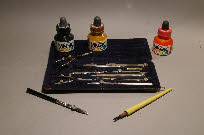 Pens
Pens
I have a range of pens for lining and lettering - bow pens, mapping pens, Rotring pens. My favourite bow pens are the oldest ones - my father’s from the 1950’s, and better than more recent ones that I have bought. I have in the past used opaque ink for loco lining, but I have developed my technique a bit more and now use enamel paints.
 Mini drill
Mini drill
Mini drills sometimes get a bad press as being only usable for stirring paint. I do use mine for that, but it also gets used a lot for cutting and grinding using abrasive discs, and removing excess solder with dentist’s burrs. It also gets used a lot for cleaning loco wheels with a rotary wire brush - less abrasive and quicker than the alternative of a glass fibre brush.
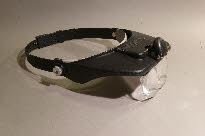 Visor
Visor
And finally number eleven in my top ten, my visor, without which nothing else would be possible!
Silhouette flat-bed cutter
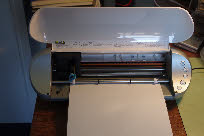 A recent addition which has been immensely useful in cutting out window frames and various other bits of plastic.
A recent addition which has been immensely useful in cutting out window frames and various other bits of plastic.
Over the years I’ve collected quite a few tools, some common, some less so, but without which I would struggle to make my models. Here’s my list of top ten, in no particular order:
 Guillotine
GuillotineI rescued this guillotine from the waste bin many years ago, and it’s done invaluable service ever since. Cutting thin metal is not easy, using either a saw or shears. A guillotine on the other hand will happily cut brass or nickel silver up to 10 or 12th, and will cut straight, and true without distortion. It will also quite happily cut roofing lead for adding weight to stock.
 Rolling mill
Rolling millMy rolling mill is a home made effort from steel rod, perspex, and a couple of Meccano gears. The two pinch rollers are adjustable to allow different thickness material to be rolled, and are connected by a pair of gears, so both move together. The third roller is also adjustable, and is used to control the tightness of the curve. I use this for rolling boilers, but have also successfully rolled Slater’s Plasticard brickwork to a radius of about 40mm to use under brick arches.
 Lathe
LatheA lathe is not cheap, but certainly worth the investment. It gets regular use for turning small items (chimneys and domes, split axles for example) and for drilling buffer shanks for sprung buffers, amongst other things. This is a Cowells lathe which I bought about 30 years ago and is still as good as new after many year’s service, shown here being used to mount a loco wheel squarely on its axle.
 Milling machine
Milling machineThis is a Unimat 3 milling machine and milling table. It gets used a lot as a vertical drill (it saves a lot of broken drills) and less often as a milling machine. My skills as a machinist are not great, but I’ve successfully milled for example, loco coupling rods and hornguides.
 Flux fume filter
Flux fume filterSolder flux fumes are pretty nasty, and if you’re doing a lot of soldering (a brass coach perhaps) in less-
 Ultrasonic cleaner
Ultrasonic cleanerAnother purchase from Maplins for about £20. Good for cleaning grease off small articles (smaller than a 4mm bogie coach for example) before painting. I’ve shown it here with a loco tender to give an idea of size. In use it would full of water -
 Grit blaster
Grit blasterIf you have an airbrush compressor, than a grit blaster is a good addition to the armoury. I use this regularly on brass and nickel silver followed by a dunk in the ultrasound cleaner, prior to painting. It gives an excellent key for paint. I tried it recently on a second hand white metal loco kit which needed a repaint. I was a bit concerned that it would be too aggressive, and pit the white metal, but it was fine, and took only about 10 minutes to strip the model back to bare metal. Don’t use the aluminium oxide sold with the grit blaster. It’s expensive, and leaves a horrible mucky residue on whatever you’re trying to clean. Use fine silver sand instead.
 Spray booth
Spray boothA recent purchase from Eileen’s, and well worth it. I can now happily spray in my garage, whereas before I could only spray stuff outside (ie in the summer) -
 Pens
PensI have a range of pens for lining and lettering -
 Mini drill
Mini drillMini drills sometimes get a bad press as being only usable for stirring paint. I do use mine for that, but it also gets used a lot for cutting and grinding using abrasive discs, and removing excess solder with dentist’s burrs. It also gets used a lot for cleaning loco wheels with a rotary wire brush -
 Visor
VisorAnd finally number eleven in my top ten, my visor, without which nothing else would be possible!
Silhouette flat-
 A recent addition which has been immensely useful in cutting out window frames and various other bits of plastic.
A recent addition which has been immensely useful in cutting out window frames and various other bits of plastic.